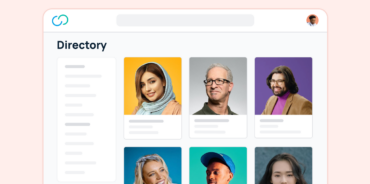Employee engagement is in decline—and it’s costing companies far more than morale. According to Gallup’s latest research, engagement has dropped to its lowest level in over a decade, contributing to higher turnover, lower productivity, and decreased profitability. Traditional recognition programs and outdated HR tools are no longer enough to address this growing issue.
To drive meaningful, measurable change, organizations are turning to a more dynamic solution: gamification software.
These platforms apply game mechanics—like points, badges, leaderboards, and challenges—to everyday workplace activities to motivate and recognize employees in a modern, scalable way. But gamification isn’t just about adding fun to work—it’s a strategic tool to boost engagement, enhance performance, and strengthen company culture from the inside out.
In this guide, we’ll explore what gamification software is, how it works, the different types available, the key benefits it offers, and the best platforms to consider.
What Is Gamification Software?
Gamification software refers to digital tools that apply game mechanics to non-game environments—like the workplace—to boost motivation, participation, and engagement. These platforms transform routine activities into interactive experiences by rewarding users for completing tasks, achieving goals, and contributing to team success.
Common gamification features include:
- Points – Earned for completing tasks or hitting performance milestones
- Badges – Digital symbols of achievement for specific accomplishments
- Levels – Indicate user progress and unlock new challenges or privileges
- Leaderboards – Display top performers to inspire friendly competition
- Quests and Challenges – Time-based missions that drive focused activity
- Progress Tracking – Visual indicators that show how far someone has come
- Instant Rewards – Recognition or tangible incentives delivered in real time
By incorporating these elements, gamification software taps into core aspects of human psychology—particularly our innate drives for achievement, recognition, status, and mastery. When people see their progress, get rewarded for their contributions, and feel part of a larger mission, they’re more likely to stay focused, committed, and enthusiastic.
In a workplace setting, gamification can take many forms. Employees might earn badges for completing training modules, climb a leaderboard based on weekly performance, or participate in a company-wide wellness challenge. These experiences not only make work more engaging but also align individual effort with organizational goals.
Ultimately, gamification software doesn’t just make tasks more enjoyable—it helps foster a culture of continuous improvement, collaboration, and recognition.
Why Use Gamification Software at Work?
Today, employees expect more than a paycheck—they seek purpose, recognition, and growth opportunities. Gamification software helps meet these expectations by creating a feedback-driven environment where engagement is embedded into daily work.
As a result, forward-thinking organizations are turning to gamification to:
Make Work More Interactive
By adding points, challenges, and progress tracking to daily tasks, gamification transforms repetitive work into something more engaging and motivating.
Drive Continuous Learning
Gamified training keeps employees involved and helps reinforce knowledge through interactive quizzes, simulations, and rewards.
Recognize Effort in Real Time
Instant feedback through badges, points, and shout-outs keeps morale high and reinforces positive efforts in real-time, without waiting for annual reviews.
Motivate Remote and Hybrid Teams
Gamified activities and leaderboards help distributed teams stay connected, aligned, and energized.
Support Culture and Collaboration
Team challenges and shared goals foster stronger collaboration and build a more inclusive, recognition-rich culture.
When implemented well, gamification software drives measurable improvements in productivity, learning outcomes, retention, and employee satisfaction.
Main Types of Gamification Software
Not all gamification tools are built the same. Here are the main types of gamification software and what they’re used for:
Learning Gamification Platforms
These platforms enhance training and educational programs by incorporating interactive quizzes, challenges, and game-like elements that increase engagement and knowledge retention. They transform traditional learning into immersive experiences.
Examples:
Kahoot! — Live quizzes and interactive games that make learning fun and memorable.
Axonify — Microlearning platform delivering bite-sized, targeted content to improve long-term retention.
Gamified CRM Systems
Customer relationship management (CRM) tools that integrate gamification to motivate sales and customer service teams. They provide real-time feedback, rewards, and competition through leaderboards and goal-based challenges, driving improved sales performance and customer satisfaction.
Example:
LevelEleven — Uses gamified scorecards and incentives to boost sales team motivation.
Employee Engagement Platforms
Tools designed to boost workplace morale, recognize achievements, and encourage collaboration by embedding gamification into company culture. They often include peer recognition, AI-driven team insights, and team-building games that help increase employee satisfaction and retention.
Example:
GoProfiles — Offers AI-powered insights, customizable peer recognition, and engaging teambuilding games.
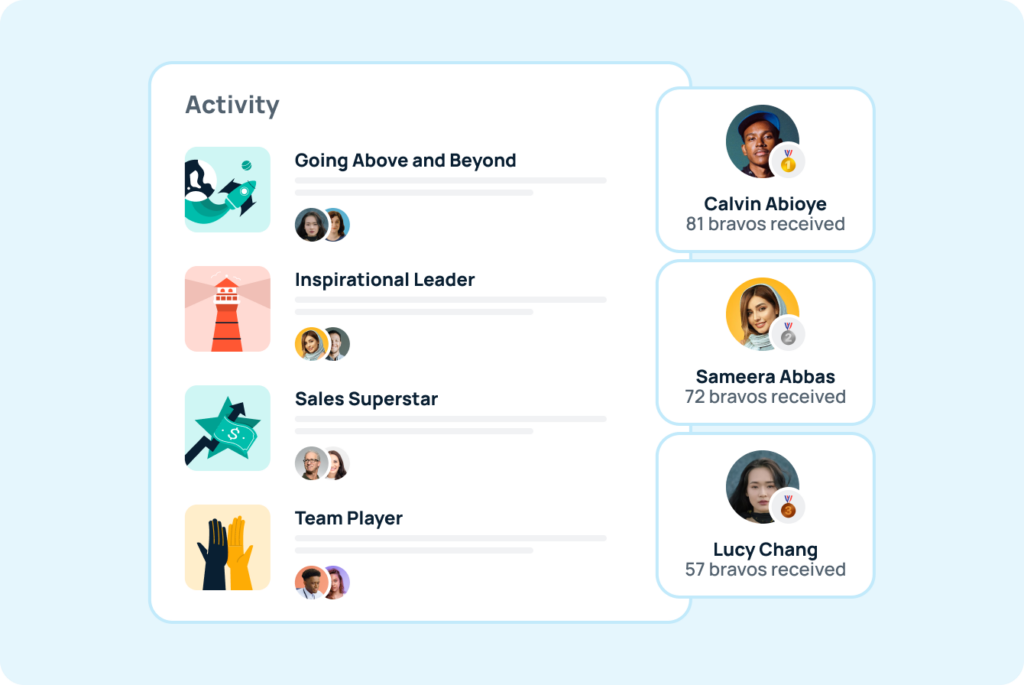
Project Management Tools with Gamification Features
Popular project management software often incorporates gamification elements such as points, badges, and progress bars to motivate teams to complete tasks on time and improve collaboration.
Examples:
Asana and Trello — Use gamified progress tracking and rewards to keep teams engaged.
Gamified Learning Management Systems (LMS)
LMS platforms use gamification to deliver training through interactive modules, certifications, and leaderboards. These features help engage learners and provide managers with progress tracking tools.
Examples:
TalentLMS and Docebo — Widely adopted for creating engaging, gamified training experiences.
Wellness and Health Apps
Focused on employee health and well-being, these apps encourage healthy behaviors like exercise, nutrition, and mindfulness through rewards and challenges, promoting overall wellness and engagement.
Example:
Virgin Pulse — Incentivizes healthy lifestyle choices through gamified wellness programs.
Core Benefits of Gamification Software
When implemented effectively, gamification software delivers measurable, business-critical benefits:
1. Increased Engagement
Interactive, game-like tasks boost participation. Employees are more likely to complete training, give feedback, and meet goals when the experience is enjoyable and rewarding.
2. Faster Learning & Better Retention
Gamified content—like microlearning and quizzes—makes training more engaging and memorable, helping employees absorb and retain information more effectively.
3. Stronger Team Collaboration
Team challenges, peer recognition, and shared goals foster connection and encourage teamwork through positive peer motivation.
4. Real-Time Performance Tracking
Leaderboards and progress dashboards give employees and managers instant visibility into performance, enabling faster course correction.
5. Ongoing Recognition
Automated rewards like points and badges provide continuous recognition, keeping morale high without extra management effort.
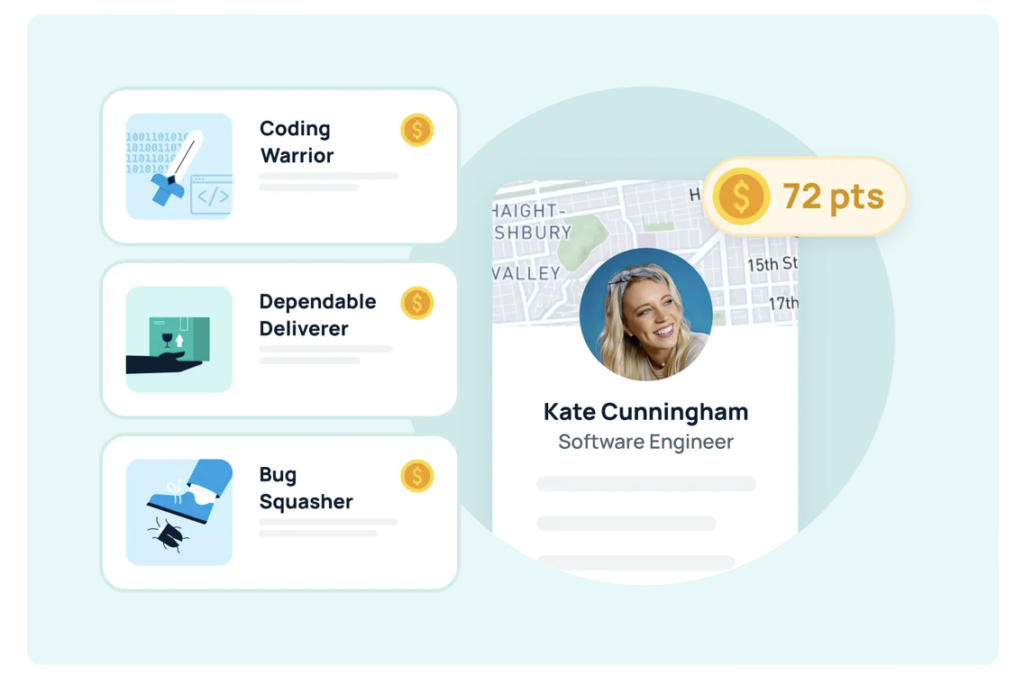
6. Reinforced Behaviors
Gamification drives action. Whether it’s knowledge sharing, wellness habits, or sales activity, incentives help embed the behaviors you want to promote.
How to Create a Gamification Strategy
To get the most value from gamification software, follow these six steps:
1. Set Clear Goals
Define success—such as higher training completion, increased sales, or better retention—to guide your platform choice and strategy.
2. Choose the Right Tool
Choose a platform that matches your goals. For culture and recognition, use tools like GoProfiles. For training, consider Kahoot! or Axonify.
3. Start Small
Start with a pilot in one team or department. Collect feedback, track engagement, and refine before scaling across the organization.
4. Incentivize Participation
Offer meaningful rewards—digital badges, company swag, or gift cards. Recognition and incentives motivate ongoing engagement.
5. Build Internal Awareness
Promote the program through Slack, email, and team meetings. Creating buzz helps drive adoption and excitement.
6. Track and Optimize
Track key metrics, gather feedback, and continuously improve. Gamification works best when it adapts to employee needs.
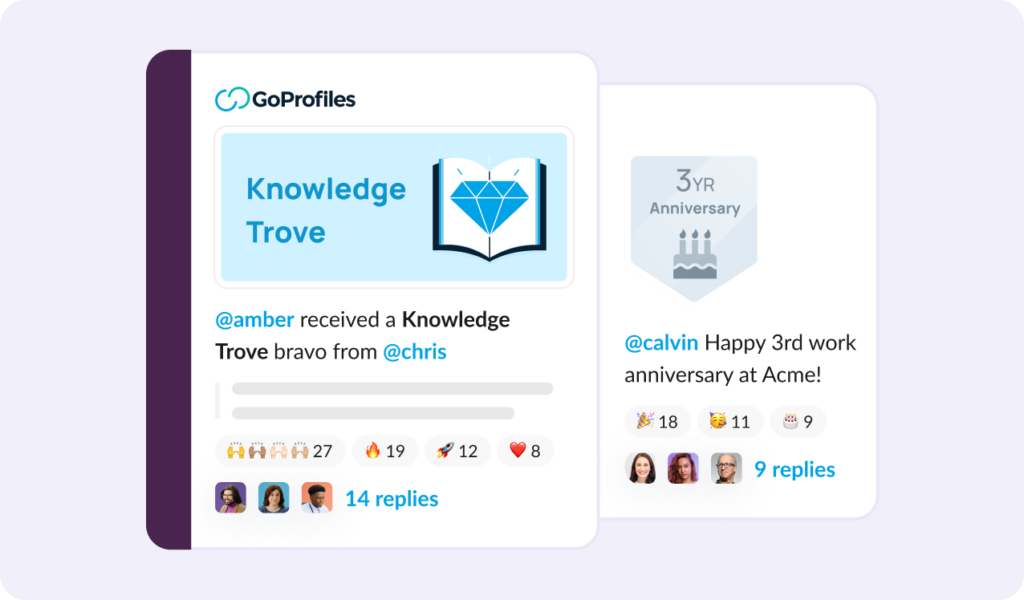
Top Gamification Platforms for 2025
These leading platforms help organizations drive engagement, performance, and learning through gamification:
| Platform | Best For | Key Gamification Features |
| GoProfiles | Employee engagement & recognition | Badges, rewards, Slack/MS Teams integration, team-building games |
| Kahoot! | Interactive learning | Quizzes, live games, points-based competition |
| Axonify | Microlearning | Personalized training, adaptive gamified content |
| LevelEleven | Sales performance | Leaderboards, scorecards, real-time CRM integration |
| TalentLMS | Training & onboarding | Gamified learning paths, certifications, progress levels |
| Bunchball | Customer loyalty & employee engagement | Custom rewards, behavioral tracking, analytics |
| Engagedly | Performance management | Real-time feedback, goal tracking, peer recognition |
| Badgeville | Enterprise-scale gamification | APIs, customizable rules, scalable reward systems |
| Mambo.IO | Full-suite gamification | Points, badges, leaderboards, modular and flexible architecture |
Getting Started with Gamification Software
Gamification software turns the employee experience into an interactive, rewarding journey. Whether you’re driving learning, boosting recognition, or energizing performance, these platforms deliver measurable impact.
GoProfiles is a standout choice for businesses focused on employee engagement, recognition, and team culture. With features like AI-driven insights, reward points, peer recognition, and Slack integration, it brings gamification into the everyday flow of work.
Ready to energize your team? Explore what GoProfiles can do for your culture and engagement.
Build a culture of connection and recognition with GoProfiles
Schedule a demo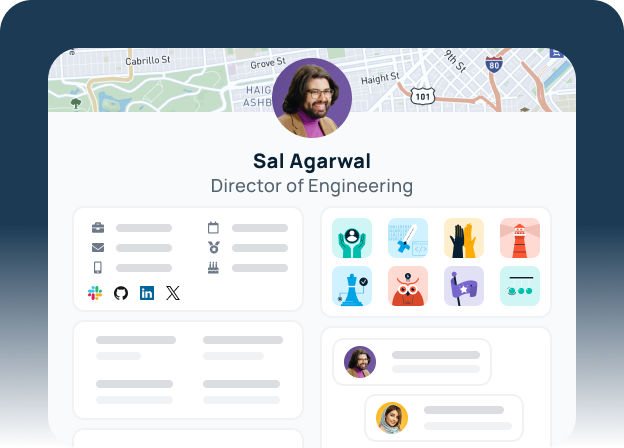
FAQs About Gamification Software
It helps drive employee engagement, learning, performance, and collaboration by adding game-like elements to business processes.
Yes. Gamification platforms are particularly effective in hybrid and remote environments where visibility, motivation, and culture can be challenging.
Gamification is worth exploring if you struggle with engagement, training, or morale. Start with a pilot to test adoption.
It’s popular in tech, healthcare, finance, education, retail, and more—anywhere employee motivation and performance are critical.
Recognition software focuses on celebrating achievements. Gamification software can include recognition but also includes broader features like goals, challenges, and learning tools.

